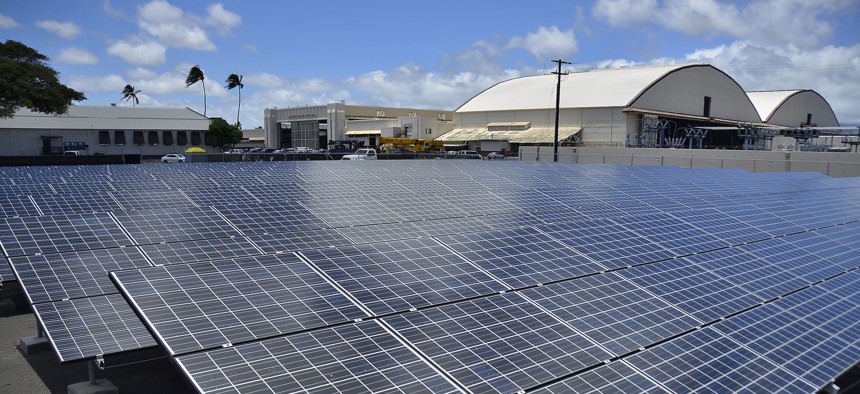
Solar panels form part of the Renewable Hydrogen Fueling and Production Station on Joint Base Pearl Harbor-Hickam. U.S. Navy / Mass Communication Specialist 2nd Class Daniel Barker
The Pentagon Could Lead the Green New Deal to Victory
Defense leaders have long braced for the impacts of climate change. Working with climate advocates could ward off those threats.
At first glance, the defense community seems an unlikely ally for the environmental advocates who have championed a Green New Deal. However, the clear national security imperative to reduce carbon output, as well as the various tactical, logistical, and financial benefits that clean-energy technologies promise the U.S. military, provides ample opportunity for collaboration.
The Defense Department has long acknowledged the threats posed by climate change. In budget documents, reports, and plans going back four administrations, defense planners have recognized that sea level rise, extreme weather, and changing climate will drive political instability in trouble spots around the globe. Closer to home, intensifying droughts, wildfires, tropical storms, and flooding have already begun to impose significant costs on military installations, as noted in DOD’s January report. Defense leaders should be motivated to reduce these threats.
Fortunately, they are uniquely positioned to take action. The U.S. military is the world’s largest single consumer of energy; it is estimated to emit more carbon than do three-quarters of the world’s nations. No other organization, and few other countries, have such a large opportunity to reduce global emissions by shifting to clean and renewable energy sources.
Related: Lawmakers Tell Pentagon: Revise and Resubmit Your Climate-Change Report
Related: As The Arctic Warms, US Navy Considering Summer Transit, Bering Sea Port
Related: Global Carbon Emissions Rose in 2018 — A Lot
Military leaders have focused on the practical and economic costs of energy issues for decades, and have been at the forefront of innovation in the energy space in securing resilience. Indeed, DOD has dramatically increased its deployment of renewable energy over the past decade — because it makes military sense to do so. Much of this has been focused on better protecting bases from outages like those suffered during recent Hurricanes Michael, Florence, and Maria. Renewable energy and microgrids are augmenting or replacing diesel generators that need refueling and even the main electrical grid, which can prove unreliable in an emergency. Other energy initiatives — transportable solar installations, waste-to-energy systems — aim to reduce the amount of diesel fuel that has to be trucked to troops operating in remote areas, and thus the costs and dangers of such operations.
Yet DOD still lags the overall U.S. economy in various ways — in 2017, the department drew only 6 percent of its electricity from renewable sources, about half as much as the United States writ large. That meant that the department significantly missed a goal set by the Energy Policy Act of 2005, which asked the DOD to secure 10 percent of its electricity from renewable energy by 2017 and 25 percent by 2025.
The military and proponents of the Green New Deal can help each other. Congress could send more money the department’s way to fund the development of clean-energy technology and the deployment of related infrastructure. This serves the military’s needs — and also speeds the arrival of products that bring down clean-energy costs for military and civilian applications.
In return, military support for the Green New Deal could persuade more skeptical Democrats and even hostile Republicans to support elements of the policy package. Many defense hawks bristled at a suggestion in the draft proposal issued by Rep. Alexandria Ocasio-Cortez, D-New York, and the Sunrise Movement to pay for the effort through deep cuts to military spending. Though this has been dropped from the final resolution championed by Ocasio-Cortez and Sen. Ed Markey, D-Massachusetts, and co-sponsored by a large number of Democrats in both houses, there is still understandable hesitation to see the national security priorities of the DOD as aligned with massive decarbonization and significant social change.
Using military spending to drive a considerable amount of the infrastructure investments and to decarbonize the U.S. government could bolster support from defense-minded politicians, lead to investment in the largely conservative communities surrounding domestic military installations, and diminish concerns that the Green New Deal is “anti-military.”
As the Pentagon has long acknowledged, climate change is a national security threat. The Green New Deal offers an avenue for the military to lead the charge in decarbonization.
Madison Freeman is a research associate with the Council on Foreign Relations.
Morgan D. Bazilian is director of the Payne Institute and Professor of public policy at the Colorado School of Mines.



